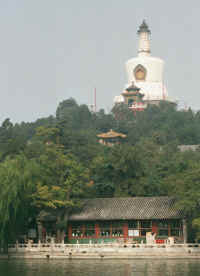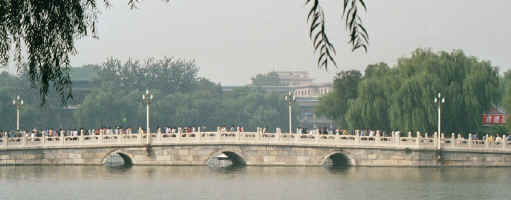 About one bus stop, or half a kilometer to the west of the north gate of the Forbidden City is the famous Beihai Park. It is used to be the former palace of the emperors in successive dynasties, called the Winter Palace by Westerners.
About one bus stop, or half a kilometer to the west of the north gate of the Forbidden City is the famous Beihai Park. It is used to be the former palace of the emperors in successive dynasties, called the Winter Palace by Westerners.
Early in the 10th century, the Liao dynasty a secondary imperial palace and an island ( Jade Islet) were built here. It was expanded by digging a lake, adding more palace halls when Jin empire took over; during the Yuan dynasty was rebuilt three times. The Ming and the Qing saw more construction and renovation: The Five Dragon Pavilions and the Nine-dragon Screen and pavilions were added. A White Dagoba, an onion-shaped shrine pagoda in Tibetan style, was erected in honor of the fifth Dalai Lama’s visit to Beijing in 1651.
Now it is a popular park with a total area of over 68 hectares, half of which is a lake. It boasts one of the best of China’s classical gardens with artificial hills, pavilions, halls, temples and covered corridors.
Most visitors enter the park through its south gate, touring the island and then walk along the eastern bank to the north gate. Have a rest at the gate and a further stoke along the western bank will feast your eyes on halls, temples and pavilions. Another choice is to enter from the south gate crossing the Beihai Bridge touring the western bank first and then ferry by boat across the lake to the Islet.
 Besides the lake, the main things to see are the Round City, which contains a jade vase from the time of Kublai Khan; the Temple of Eternal Peace; the Nine Dragon Screen, which is actually a 5-metre-high, 27-metre-long wall covered with glazed tiles carved into nine intertwining dragons; and the White Dagoba on Jade Isle in the center of the lake.
Besides the lake, the main things to see are the Round City, which contains a jade vase from the time of Kublai Khan; the Temple of Eternal Peace; the Nine Dragon Screen, which is actually a 5-metre-high, 27-metre-long wall covered with glazed tiles carved into nine intertwining dragons; and the White Dagoba on Jade Isle in the center of the lake.
Round City
A round building surrounded by a 5-meter-high wall, the Round City stands at the south gate of Beihai Park, and has a distinctive courtyard studded with halls, pavilions and ancient trees.
The Hall of Receiving Light (Chengguangdian) houses a statue of Buddha, 1.5 meters high, carved from a block of lustrous jade, a present from Burma to Empress Dowager Cixi. In the Jade Urn Pavilion at the center of the Round City is a jade urn, 0.66 meter in height and 1.5 meters in diameter, which was believed to be a wine vessel by Kublai Khan. Fancy decorative patterns of clouds, dragons and animals on the surface reveal the exquisite craft of consummate craftsman.
Jade Islet
The Jade Islet, the center of the park, features luxuriant trees and a host of temple halls. Atop the isle is the 35.9-meter-high White Dagoba. The dagoba together with a painting depicting Emperor Shunzhi (the first emperor of the Qing) meeting with the Fifth Dalai is the witness of the Central Government-Tibet alliance at that time. The top is a gold-gilded copper lid decorated with dozens of bells with jingle far in the wind. In front of the Dagoba stand the Temple of Enternal Peace (Yong’an si) and Hall of Universal Peace. At the back of the island is Hall of Rippling Water.
West Bank
Opposite the Jade Isle across the lake on the west bank are unique buildings. The Five-Dragon Pavilions – a zigzag line of five glaze-tiled pavilions over the water were built in 1602 and renovated several times under the Qing. The Qing emperors used to go fishing there.
The Iron Shadow Screen ( Tieyingbi), 3.56 meters long and 1.9 meters high, was built in the Yuan. The iron-colored screen was carved out of neutral igneous rock.
Nine-Dragon Screen
Just like the one in the Forbidden City, the screen is built with colored glazed-tiles, It was used to protect a temple (no long there now) from invading evil spirits, and is considered an art treasure and one of the best of its kind.
In summer, Beihai is an ideal place to escape from heat.